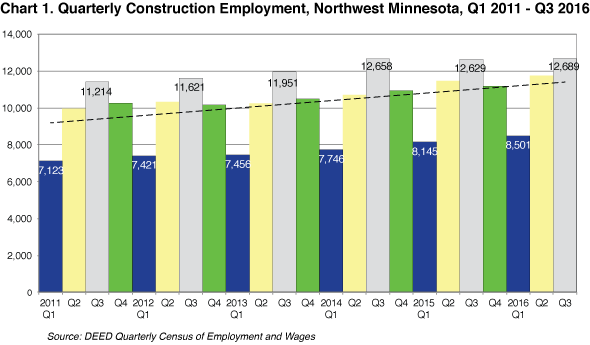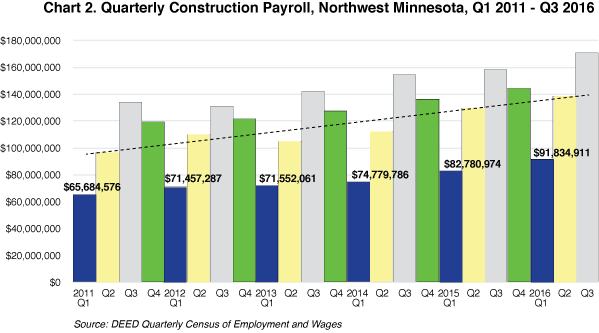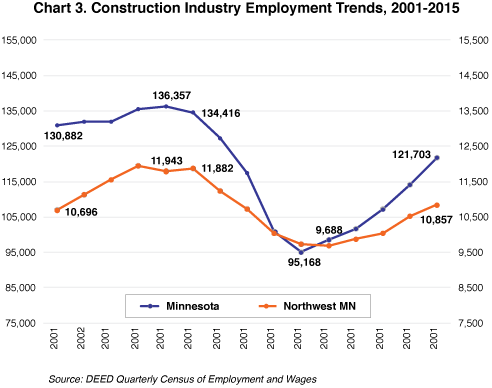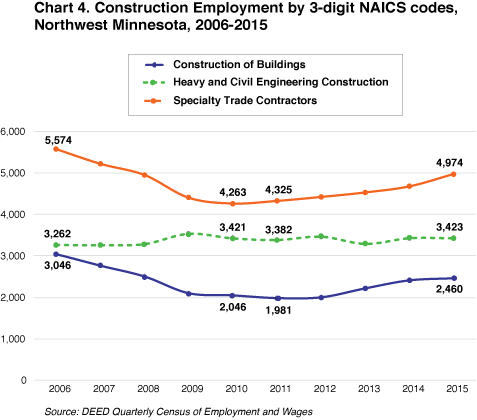by Chet Bodin and Cameron Macht
April 2017
As spring blooms in Minnesota, so does the construction industry across the state – and many workers in Northwest Minnesota are ready to trade in their winter hats and boots for hard hats and tool belts. Data from DEED's Quarterly Census of Employment & Wages program show that construction hiring in Northwest Minnesota is extremely seasonal, fluctuating between a low of 8,500 jobs in the first quarter to a recent peak of almost 12,700 jobs in the third quarter of the past year (see Chart 1).

Construction employment in the region regularly jumps by well over 4,000 jobs from the first quarter to the third quarter each year. These additional temporary and seasonal jobs are a positive boost, but the steady climb of first quarter employment year-over-year is also encouraging. Given the seasonal aspects of construction work, first quarter jobs are a good indicator of full-time, year-round employment. As shown in Chart 1, first quarter (January – March) construction employment increased every year from 2011 to 2016 – expanding 19.3 percent during that time – a strong sign that employers are staying busy and needing to keep a larger permanent workforce year-round.
Total wages paid by the construction industry in Northwest Minnesota also increased in the first quarter each year from 2011 to 2016 (see Chart 2). The difference in first quarter activity from 2015 to 2016 is exceptional, as Northwest Minnesota had 356 more construction jobs in the first quarter of 2016, and employers paid over $9 million more in wages.

In addition to the seasonal ups and downs, the region's construction employers have also weathered some serious annual ebbs and flows over the past 15 years. Payrolls built up quickly from 2001 to 2004 as the regional building market was red hot, then started to decline with the housing bubble that burst in 2006. From 2006 to 2011 the construction industry in Northwest Minnesota shed nearly 2,200 jobs, which accounted for over one-third of the total job losses across all industries in the region during that time.
The region's construction employers cut nearly 18.5 percent of their jobs from 2006 to 2011, although that was less severe than statewide, where construction employment dropped 26.6 percent during the Great Recession. Fortunately, recent trends show that the construction industry appears to have stabilized in Northwest Minnesota, with steady year-over-year gains reported from 2011 to 2015. Interestingly, the 10,857 jobs posted in 2015 was nearly identical to the number of jobs recorded in 2001 before the housing bubble build-up (see Chart 3).

The recent job growth and stabilization in the construction industry is a welcome sign, as it was one of the last major industries in Northwest Minnesota to recover from the Great Recession. However, the industry has changed compared to its pre-recession composition. Among the three major subsectors of construction, specialty trade contractors employ the most workers and lost the most during the recession. These contractors lost over 1,300 jobs through 2010, but over half of those losses have since returned (see Chart 4).

In contrast, the heavy and civil engineering construction subsector has over 150 more jobs now than before the recession. The industry was buoyed by highway infrastructure projects like roads and bridges and therefore did not experience the same losses that contractors and builders did from 2006 to 2010. The region's strength in heavy and civil engineering construction helped keep the industry afloat until the other subsectors were able to rebound and undoubtedly softened the economic blow for many living in the area. However, it has not contributed significantly to the construction industry's recovery since 2011, gaining just 40 jobs since then.
As shown in Chart 4, the number of jobs in heavy construction and civil engineering was similar to the number of jobs in construction of buildings prior to the recession, but now outnumbers those in building construction by nearly 1,000 jobs. The construction of buildings subsector has seen much greater growth since 2011, adding almost 500 net new jobs, but it is still nearly 600 jobs shy of the number posted in 2006.
The number of new construction firms – both employers and self-employed workers – starting up in Northwest Minnesota has decreased since 2011. Instead, a closer look at the employment data indicate that most recent job gains have come from business expansions, where existing firms in the region have been keeping and adding workers from one quarter to the next.
With an annual average of about 10,800 jobs at about 2,100 establishments in 2015, construction was the eighth largest employing industry in Northwest Minnesota, but also had the second largest number of establishments, behind only retail trade. Most construction employers are small businesses, averaging about five employees per establishment, compared to about 13 employees per business across all industries in the region.
In addition, the region was home to 6,130 self-employed construction workers according to data from the U.S. Census Bureau's Nonemployer Statistics program. These nonemployers reported sales of nearly $360 million in 2014. However, like covered employment, the number of self-employed construction workers in the region also declined over the past decade, falling from 7,349 nonemployers in 2004.
Despite that, the region's recent economic recovery has led to positive projections for the construction industry in the future. Construction is projected to be both the third fastest and third largest growing sector in Northwest Minnesota over the next decade, with only health care and social assistance ranking ahead of it in both categories of growth. If these projections remain accurate, the construction industry may add just over 1,400 new jobs by 2024, a 14 percent growth rate that is more than three times faster than the regional projected growth rate across all industries.
The job gains are expected to be spread across the various construction subsectors, with the biggest expansion occurring in heavy and civil engineering construction, followed by specialty trade contractors, and the smallest gain logged in construction of buildings (see Chart 5).

Although the work will remain seasonal, projected growth should lead to steady demand for new construction workers in the next 10 years. According to DEED's Employment Outlook tool, all but one construction occupation is expected to see new job growth in the region during the decade, including six occupations that are projected to grow more than 10 percent (see Table 1).
| Table 1. Employment Projections for Construction Occupations in Northwest Minnesota | |||||||
|---|---|---|---|---|---|---|---|
| SOC Code | Occupation | Estimated Employment 2014 | Projected Employment 2024 | Percent Change 2014-2024 | Numeric Change 2014-2024 | Replacement Openings 2014-2024 | Total Openings 2014-2024 |
| 0 | Total, All Occupations | 259,813 | 269,061 | 3.5% | 9,248 | 61,000 | 74,670 |
| 470000 | Construction and Extraction Occupations | 12,393 | 13,564 | 9.4% | 1,171 | 1,940 | 3,110 |
| 471011 | First-line Supervisors of Construction Workers | 642 | 689 | 7.3% | 47 | 50 | 90 |
| 472031 | Carpenters | 2,967 | 3,204 | 7.9% | 237 | 340 | 570 |
| 472051 | Cement Masons and Concrete Finishers | 538 | 604 | 12.2% | 66 | 60 | 130 |
| 472061 | Construction Laborers | 1,840 | 2,067 | 12.3% | 227 | 360 | 590 |
| 472071 | Paving, Surface and Tamping Equip. Operators | 154 | 180 | 16.8% | 26 | 30 | 60 |
| 472073 | Operating Engineers and Equipment Operators | 1,111 | 1,253 | 12.7% | 142 | 180 | 320 |
| 472111 | Electricians | 1,029 | 1,108 | 7.6% | 79 | 150 | 230 |
| 472151 | Pipelayers | 47 | 51 | 8.5% | 4 | 0 | 10 |
| 472152 | Plumbers, Pipefitters, and Steamfitters | 732 | 773 | 5.6% | 41 | 90 | 130 |
| 472181 | Roofers | 117 | 127 | 8.5% | 10 | 10 | 20 |
| 472211 | Sheet Metal Workers | 223 | 218 | -2.2% | -5 | 40 | 40 |
| 474011 | Construction and Building Inspectors | 128 | 138 | 7.8% | 10 | 30 | 40 |
| 474051 | Highway Maintenance Workers | 939 | 978 | 4.1% | 39 | 250 | 280 |
| 474071 | Septic Tank Servicers and Sewer Pipe Cleaners | 49 | 59 | 20.4% | 10 | 10 | 20 |
| 475000 | Extraction Workers, All Other | 69 | 86 | 24.6% | 17 | 10 | 30 |
| Source: DEED Employment Outlook tool | |||||||
While it has not added back all the jobs it lost during the recession, the construction industry has been rebuilt in Northwest Minnesota. Projections indicate the industry will continue to grow in a positive direction in the future. For current and prospective construction workers, the outlook is good. Seasonal employment is still high, but permanent jobs appear to be more available now as well.